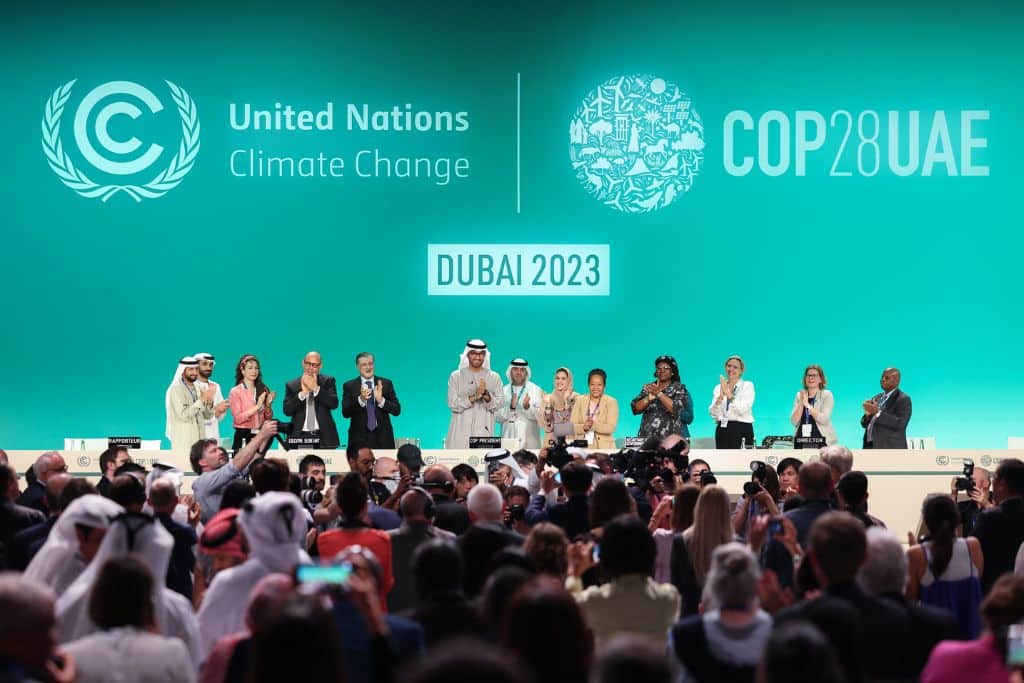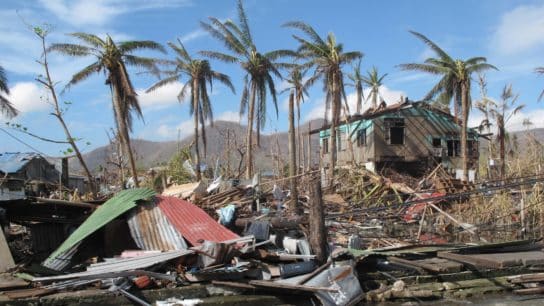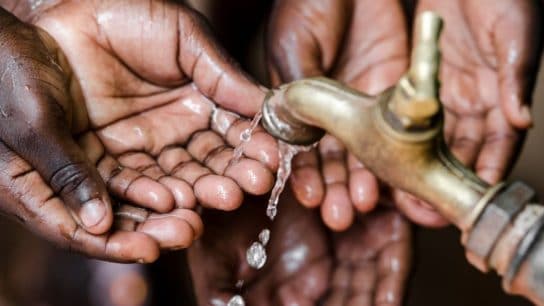A major international climate change conference has just concluded in Bonn, Germany. The yearly event sets the stage for the topics that will be covered during the upcoming COP29 summit in Baku, Azerbaijan. Here are the main takeaways from the conference and how they will influence negotiations in November.
—
What Is the Bonn Climate Change Conference?
Held annually by the United Nations, the Bonn Climate Change Conference is the mid-year gathering of the Subsidiary Body for Implementation (SBI) and the Subsidiary Body for Scientific and Technological Advice (SBSTA). The Subsidiary Bodies only meet twice a year: in Bonn in the middle of the year and at the Conference of the Parties (COP), which is typically held between November and December.
Formally known as the Sessions of the United Nations Framework Convention on Climate Change (UNFCCC) Subsidiary Bodies (SBs), the 60th meeting of the Subsidiary Bodies (SB60) concluded earlier this month.
UNFCCC countries negotiate procedures for implementing agreements reached at the previous COP, and the outcomes are likely to influence discussions and negotiations at COP, with recommendations made at the June meetings often appearing in the final decisions acted upon by parties at the UN summit.
You might also like: Explainer: What Is the UNFCCC?
What Were the Key Outcomes of SB60?
Here is a summary of some of the outcomes. The full report can be found here.
1. Climate Finance
One of the central issues at the Bonn 2024 conference was the ongoing negotiation over climate finance, particularly the New Collective Quantified Goal (NCQG). The NCQG aims to mobilise substantial financial resources from developed nations to support climate action in developing countries. This goal is set to replace the $100 billion target established at COP21 in Paris. Negotiations at Bonn sought to lay the groundwork for more ambitious and achievable targets post-2025. However the process of negotiating the NCQG has faced significant challenges. Nations have disagreed on almost every aspect of the new target, including the total amount of money to be provided, the contributors, the recipients, and the types of funds to be included.
Developing countries consistently argued for climate finance to be provided in the form of grants rather than loans, to avoid further indebting nations already grappling with economic challenges exacerbated by climate impacts. They emphasised that grants would provide more direct and effective support for their mitigation and adaptation efforts, enabling them to tackle climate impacts without the added strain of loan repayments.
The Climate Action Network (CAN) – a global network of more than 1,900 civil society organisations in over 130 countries – highlighted the need for the European Union (EU) to make clear moves in support of an ambitious climate finance agreement, emphasising that the bloc “must be a driving force for agreeing a robust new climate finance goal for post-2025 that centres public finance and is needs-based, fair, and equitable.”
The conference also saw intense discussions on the allocation of climate finance across different needs, including mitigation, adaptation, and loss and damage (see point 3), with delegates emphasising the need for balanced allocation to ensure comprehensive support in all climate action areas.
Despite these efforts, there were substantial disagreements amongst delegates regarding the accountability and transparency of financial commitments. Developing countries demanded clear mechanisms to ensure that pledged funds are delivered and effectively utilised. The lack of progress on these fronts was a major point of contention, with several delegates expressing frustration at the slow pace of negotiations.
Simon Stiell, UNFCCC Executive Secretary, underscored the urgency of resolving these issues, stating: “We’ve left ourselves with a very steep mountain to climb to achieve ambitious outcomes.” His remarks reflected a broader sentiment that while some progress was made, the pace and scale of commitments need to be significantly ramped up to meet the demands of the climate crisis.
2. Article 6
Article 6 of the Paris Agreement includes provisions for both market-based and non-market-based approaches to carbon reduction.
In Bonn, significant strides were made to clarify the rules for implementing Articles 6.2 and 6.4. The former allows for the transfer of carbon credits between countries through bilateral or multilateral agreements, while the latter establishes a centralised mechanism for creating and trading high-quality carbon credits.
Delegates focused on ensuring that carbon markets operate with high transparency and environmental integrity. However, these discussions also highlighted several challenges that need to be addressed before finalising the mechanisms at COP29.
More on the topic: Explainer: What Is Article 6 of the Paris Agreement?
A primary concern in the negotiations was maintaining the environmental integrity of carbon markets. Delegates worked on establishing robust monitoring, reporting, and verification (MRV) systems to ensure that carbon credits represent real, measurable, and additional emissions reductions. Developing countries emphasised the need for capacity building and technical assistance to effectively participate in carbon markets. The discussions highlighted the importance of providing these countries with the necessary resources and expertise to develop and implement carbon market projects.

Progress was also made on the operational details of the Article 6.4 mechanism, which is intended to function similarly to the Clean Development Mechanism (CDM) under the Kyoto Protocol, albeit with enhanced features. Delegates discussed the roles and responsibilities of the supervisory body, the processes for approving and validating projects, and the criteria for issuing carbon credits. These discussions aimed to ensure the mechanism supports high-quality projects that deliver genuine emissions reductions. However, while significant strides were made, it remains to be seen if these objectives will be fully met. The emphasis on establishing robust MRV systems is promising, but the effectiveness of these measures will depend on their implementation and enforcement in practice.
3. Loss and Damage Fund
With the fund set up and attention turning to the new, post-2025 climate finance target – the NCQG – the Loss and Damage Fund (LDF) was less prominent in the Bonn discussions. Set up at COP27 in Egypt, the LDF aims to provide financial assistance to countries and communities of the Global South that are most vulnerable to the adverse impacts of climate change. The LDF was first proposed to compensate vulnerable countries for these damages, and its operationalisation at COP28 was viewed as a “historic” achievement.
More on the topic: Explainer: What Is Loss and Damage Compensation?
One of the many sticking points in the discussion of the NCQG was developing countries’ insistence that there should be a separate “window” specifically earmarked for loss and damage, as well as funds for mitigation and adaptation. A joint document submitted by the LDCs and the Alliance of Small Island States (AOSIS) emphasised that the money for this loss and damage “sub-goal” in the NCQG should predominantly come from public and grant-based money. However, developed countries opposed this view, arguing that loss and damage finance is not part of the NCQG’s mandate. They contended that including it within the target would stretch existing resources thinner, rather than provide new finance.

The question of loss and damage finance was deferred until COP29, with parties unable to find any compromise.
4. Adaptation and Mitigation Strategies
Adaptation strategies – which focus on adjusting to the effects of climate change, and mitigation strategies – aimed at reducing greenhouse gas emissions, were also at the center of negotiations.
A significant portion of the Bonn discussions centred on the Global Goal on Adaptation (GGA). Established in the 2015 Paris Agreement, the goal seeks to enhance adaptive capacity, strengthen resilience, and reduce vulnerability to climate change. The Adaptation Committee’s report highlighted that while some progress has been made, many countries, particularly developing nations, still lack the necessary resources and infrastructure to implement effective adaptation strategies.
Stiell stressed the urgency of scaling up adaptation efforts, noting that “adaptation is not an option but a necessity for survival for many communities around the world.” He urged developed nations to increase their support, both financially and technically, to help vulnerable countries build resilience against climate impacts. Delegates also emphasised the need for robust frameworks to measure and track progress in adaptation efforts.
Mitigation strategies were also debated, focusing in particular on the implementation of the Mitigation Ambition and Implementation Work Program (MWP), which aims to accelerate efforts to reduce emissions in line with the Paris Agreement targets. However, the discussions revealed significant divisions among parties. Some countries pushed for more ambitious targets and immediate action, while others, particularly those reliant on fossil fuels, were more cautious about committing to stringent emissions reductions.
The importance of integrating the outcomes of the Global Stocktake (GST) into the MWP was another recurring theme. The GST, which assesses collective progress towards the Paris Agreement goals, indicated that current efforts are insufficient to limit global warming to 1.5C. Delegates discussed how the findings of the GST could inform and enhance national climate action plans, known as Nationally Determined Contributions (NDCs), to ensure they are more ambitious and aligned with global climate goals.
Lastly, mitigation discussions also touched upon the contentious issue of phasing out fossil fuels. At COP28, countries pledged for the first time to “transition away” from fossil fuels towards renewable energy sources. In Bonn, delegates worked on operationalising this commitment, exploring pathways to implement just transitions that do not disproportionately impact vulnerable populations. This included debates on financial mechanisms to support workers and communities dependent on the fossil fuel industry as they transition to greener economies.
You might also like: Assessing Global Progress on Climate Adaptation
The Road to COP29
The 2024 Bonn Climate Change Conference has highlighted both progress and challenges in global climate negotiations. Despite some advancements in areas such as climate finance and carbon market mechanisms, significant disagreements and setbacks persist, particularly in addressing loss and damage and ensuring effective adaptation and mitigation strategies.
The outcomes of Bonn 2024 lay the groundwork for critical decisions at COP29. All parties must intensify their efforts to bridge divides and work collaboratively to meet urgent challenges posed by climate change. All eyes are now on Azerbaijan, the host nation for COP29, a country with significant fossil fuel interests. Criticisms regarding Azerbaijan’s human rights record and its plans to expand gas operations highlight the complexities involved in setting ambitious climate finance goals and ensuring that the commitments made translate into actionable plans.
Featured image: UNclimatechange/Flickr.
This story is funded by readers like you
Our non-profit newsroom provides climate coverage free of charge and advertising. Your one-off or monthly donations play a crucial role in supporting our operations, expanding our reach, and maintaining our editorial independence.
About EO | Mission Statement | Impact & Reach | Write for us














